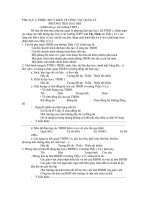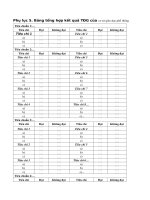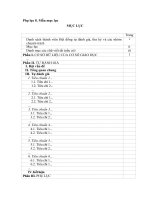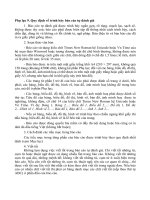Phụ lục beta blockers COPD
Bạn đang xem bản rút gọn của tài liệu. Xem và tải ngay bản đầy đủ của tài liệu tại đây (1.4 MB, 89 trang )
Beta blockers & COPD/asthma
Quan Nguyen Anh, MD
Structure of presentation
Case study
Beta blockers – Overview
COPD & heart diseases – Overview
Under-use of beta-blockers in patients with ischaemic heart disease and concomitant COPD
Effectiveness of beta-blocker therapy after AMI in elderly patients with COPD or asthma
Use of Beta Blockers in CHF Patients with COPD and/or Asthma
Cardioselective beta-blockers ?
Non-cardioselective beta-blockers ?
Non-selective alpha- & beta-blockers ?
Case study 1
Male, 85 years old
COPD
Stent LAD1
BP: 170/80
=> Isolated systolic hypertension
=> First line agents:
- Thiazide diuretics
- ARB
- Long acting DHP CCB
- BB (???)
Case study 2
Male, 79 years old
Prescription at discharge:
3-vessel coronary heart disease – HF (LVEF: 28 %) – Asthma.
Re-admission many times due to breathlessness, well tolerated with bronchodilatory,
vasodilatory agents & diuretics.
- Clopidogrel
- Berodual, Seretide, Bambec…
- Zestril, Furosemide, Nitrat…
- Not BB (!!!)
Case study 3
Male, 50 years old
Admitted to Emergency Department: Anterior MI day 2 with bronchospasm appearance, well
tolerated with bronchodilatory agents
Smoking – many years; occasional breathlessness related to weather, unconfirmed asthma,
no prevention. His son is allergic to seafood with presentation of rash & itching.
-> C3: BP 130/80, HR: 85 bpm, no bronchospasm appearance at all.
=> Use of BB??? If yes, when & how???
Beta blockers – Overview
Beta blockers - contraindications
Bradycardia, especially high degree AV block
Serious HF
Bronchospasm pulmonary diseases (COPD, asthma)
PAD
Cautious in patients with DM, dyslipidemia (increase LDL-C & TG, decrease HDL-C)…
Beta blockers – NOW: indications
Hypertension (not recommended for patients ≥ 60 years old without another compelling
indication)
Coronary heart disease (Angina, UA, post MI)
CHF (bisoprolol, metoprolol, carvedilol)
Tachyarrhythmias (…)
Perioperative period (…)
Beta blockers – NOW: indications
In a retrospective study of more than 200,000 patients with myocardial infarction, Gottlieb et
al found that beta-blockers were associated with a 40% reduction in mortality rates in
patients with conditions often considered a contraindication to beta-blocker therapy, such as
congestive heart failure, pulmonary disease, and older age.
Gottlieb SS, McCarter RJ, Vogel RA. Effect of beta-blockade on mortality among high-risk and low-risk patients after myocardial
infarction. N Engl J Med 1998; 339:489–497.
Beta blockers - classification
β1-Adrenoceptors are situated in the cardiac sarcolemma. If activated, they lead to an increase in
the rate and force of myocardial contraction (positive inotropic effect) by opening the calcium
channels.
β2-Adrenoceptors are found mainly in bronchial and vascular smooth muscles. If activated, they
cause broncho- and vaso-dilatation. There are, however, sizable populations of β2-Adrenoceptors in
the myocardium, of about 20%–25%, which leads to the cardiac effects of any β2-Adrenoceptors
stimulation. There is a relative up-regulation of these receptors to about 50% in heart failure.
Beta blockers - classification
The first generation agents (Propranolol, Sotalol, Timolol, Nadolol…): nonselective
- Blocking β1-receptors: affects the heart rate, conduction and contractility.
- Blocking β2-receptors: tends to cause smooth muscle contraction -> bronchospasm.
The second-generation agents (Atenolol, Bisoprolol, Metoprolol…): selective
- Block β1-receptors in low doses but are capable of blocking β2-receptors in higher doses.
Beta blockers - classification
The third generation agents: selective (Nebivolol) or nonselective (Carvidolol and Labetolol).
- These agents have vasodilatory properties mediated either by nitric oxide release
(Nebivolol, Carvidolol) or by added alpha-adrenergic blockade (Labetolol, Carvidolol) or
- acts via β2-intrinsic sympathomimetic activity (ISA) (Pindolol, Acebutolol): capacity to
stimulate as well as to block adrenergic receptors.
Beta blockers - classification
Int J Chron Obstruct Pulmon Dis. 2007 December;
2(4): 535–540.
MECHANISMS OF BETA-BLOCKADEINDUCED BRONCHOCONSTRICTION
Beta-adrenergic stimulation inhibits release of acetylcholine, a potent bronchoconstrictor,
from cholinergic nerves in human airways.
In patients with asthma, non-selective beta-adrenergic blockade may cause
bronchoconstriction by antagonism of inhibitory presynaptic beta-2-adrenoreceptors on
cholinergic nerves.
Patients with COPD, unlike those with asthma, experience equal or better bronchodilator
responses to anticholinergic agents than to beta-adrenergic agonists.
MECHANISMS OF BETA-BLOCKADEINDUCED BRONCHOCONSTRICTION
Beta-2-adrenoreceptors and cholinergic M2 receptors have opposite effects on adenylyl
cyclase activity. A rise in cAMP level relaxes smooth airway muscle. Stimulation of
cholinergic M2 receptors reduces adenylyl cyclase activity, thereby counteracting beta-2agonist–induced airway smooth muscle relaxation.
Accordingly, beta-adrenergic blockade may result in unopposed acetylcholine-mediated
bronchoconstriction. Considerable heterogeneity of cholinergic M2 receptors in patients
with COPD may explain the variability in the airway response to beta-adrenergic blockade.
MECHANISMS OF BETA-BLOCKADEINDUCED BRONCHOCONSTRICTION
Alternatively, the bronchoconstrictor effect of beta-blockers may not be directly related to
beta-adrenoreceptor blockade.
Alpha-1-adrenergic–blocking agents produce mild bronchodilation in patients with
obstructive airway disease.
Thus, partial or complete beta-2-adrenoreceptor blockade with unopposed activation of
alpha-receptors may be responsible for bronchoconstriction induced by non-selective betablockade.
COPD & heart diseases – Overview
COPD
The fourth leading cause of death and is estimated to rise to be the third most common cause
of death worldwide by 2020.
Reilly JJ, Silverman EK, Shapiro SD. 2005. Chronic obstructive pulmonary disease In Harrison’s principles of internal medicine
textbook.1547–9.
Many patients with COPD have concomitant conditions, mostly coronary artery disease
(CAD) – smoking (!), coexists in up to 27% of COPD patients.
Karoli NA, Rebrov AP. Chronic obstructive lung disease and coronary heart disease. Klin Med (Mosk) 2005;83:72–6.
Lung function in CHF & COPD
COPD
The most common comorbid conditions associated with withholding BBs in elderly patients after
myocardial infarction (MI) are COPD and asthma.
Heller et al., Am Heart J. 2000 Oct;140(4):663-71
Many patients are diagnosed and treated for COPD with no objective evidence, such as pulmonary
function tests or specialist assessment, to confirm the diagnosis => a significant number of patient
are deprived the prognostic benefits of using BBs (???)
COPD patients are at greater risk of ischaemic heart disease than asthmatics, so would benefit from
the use of BBs.
On the other hand, they also have more severe airway obstruction, so may be more sensitive to small
changes in FEV due to beta-blockade.
1
Under-use of beta-blockers in patients with ischaemic heart
disease and concomitant COPD
M. EGRED, S. SHAW, B. MOHAMMAD, P. WAITT and E. RODRIGUES
From the Cardiothoracic Centre and Aintree Cardiac Centre, University Hospital Aintree, Liverpool, UK
Q J Med 2005; 98:493–497
Under-use of beta-blockers in patients with
ischaemic heart disease and concomitant
COPD
Aim: To assess the use of BB in patients with COPD admitted with acute coronary syndrome
(ACS), and to assess the supporting evidence for the diagnosis of COPD in these patients
Method: Case-note review and retrospective analysis of 457 consecutive patients admitted
with troponin-positive ACS between October 2002 and October 2003
Under-use of beta-blockers in patients with
ischaemic heart disease and concomitant
COPD
Results:
- Of 457 ACS patients studied, 246 (54%) were discharged on a BB.
- Cardiologists prescribed BB in ACS patients more frequently than did general physicians (70% vs. 30%,
respectively).
- The reasons for withholding BB were: not documented 27%, COPD 33%, heart failure 24%, others 16%.
- 94 patients (21%) had a diagnosis of COPD; only 58 (62%) of these had been reviewed by a chest physician
or had previous pulmonary function tests. Of the 94 patients with COPD, only 15 (16%) were prescribed BB
during the admission: 9 by cardiologists and 6 by non-cardiologists. BB were discontinued in two patients due
to an increase in dyspnoea.
Under-use of beta-blockers in patients with
ischaemic heart disease and concomitant
COPD
Conclusion: Many patients with a diagnosis of COPD have no objective evidence to support
the diagnosis and are denied the prognostic benefits of BB when presenting with ACS.
Before withholding beta-blockers, COPD and reversibility should be ascertained by
pulmonary function testing. The overall use of beta-blockers remains sub-optimal and could
be improved in this setting.
Guidelines
“while relative contraindications may once have been thought to preclude the use of betablockers in some patients, new evidence suggests that the benefits of beta-blockers in
reducing re-infarctions and mortality may actually outweigh their risks, even in patients with
asthma … [and] chronic obstructive pulmonary disease”
American Medical Association. Quality Care Alert: beta-blocker prophylaxis after acute myocardial infarction. Chicago, IL:
American Medical Association, 1998.









